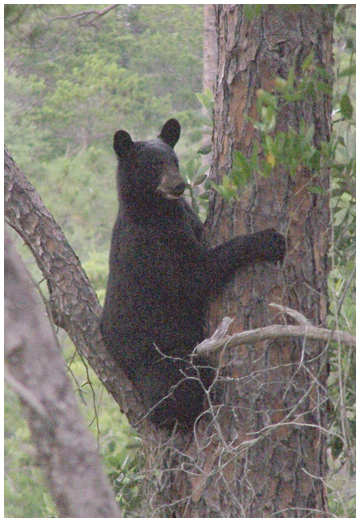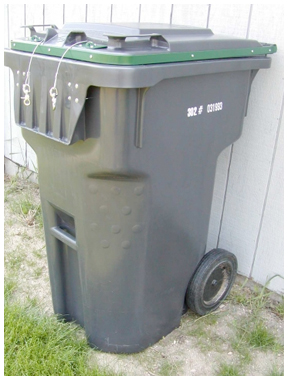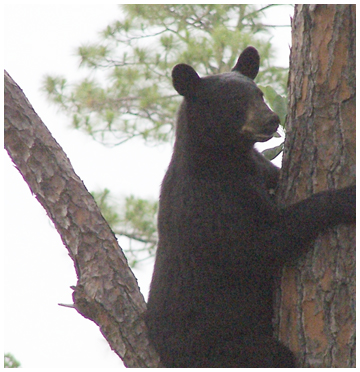
Yes, we have bears in the Florida Panhandle!
The presence of bears is not necessarily a problem or a threat to your safety. For many people seeing a black bear is a thrilling, rewarding experience.
Problems arise when bears have access to food sources unintentionally made available by people such as pet foods, garbage, barbecue grills, bird seed or livestock feed. Bears are adaptable and learn very quickly to associate people with food. Black bears are normally too shy to risk contact with humans, but their strong food drive can overwhelm these instincts.
The Florida black bear is a unique subspecies of the American black bear, and is listed as a threatened species in Florida and is the state’s largest land mammal. Black bears once ranged throughout Florida but now live in several fragmented areas across the state.
Since the 1980s, the black bear population has been expanding along with our human population. Florida has grown from 5 million residents in 1960 to close to 18 million today and is projected to reach almost 36 million by 2060. Urban sprawl is encroaching on traditionally remote areas and bringing people into prime bear habitat. As a result bears and people are encountering each other more than ever.
The Florida Fish and Wildlife Conservation Commission (FWC) has a wildlife alert number and also encourages state visitors and residents to contact FWC Regional Offices for assistance on what to do if they see a bear. Now that the populations of bears and humans have increased and outreach efforts have made these resources more widely known, the bear-related calls have reached a record number with 2,674 in 2007. Many of these calls are simply sightings or reports of a sick or injured bear, but many report problems such as a bear in the garbage, a bear at the birdfeeder or other property damage.
A fed bear is a dead bear
Anything that smells like food and can be easily accessed is a potential bear attractant. Presently garbage is by far the biggest bear attractant in Florida. Garbage may be disgusting to us but to bears it is a buffet line of food. Bears can smell garbage, pet food and other food smells from over a mile away! Bears can travel great distances to track down smells from food and unsecured garbage, and often cross roadways and bridges to do so- which creates risk to themselves and motorists.
Bears are very intelligent animals that can be attracted into neighborhoods, residential areas and human occupied areas by a wide variety of foods and smells. Bears that gain access to human foods quickly learn to associate people with food and gradually loose their shyness around humans (habituated). These bears may return more frequently and may become bolder around people. Once a bear becomes used to getting a food source (food conditioned) the battle has already been lost. Black bears are persistent, strong and resourceful and can tear up trash cans, dumpsters, sheds, outbuildings, birdfeeders, doghouses, smokers, grills and coolers to get to food. They can become aggressive when defending a steady source of food. The bear’s expectation of receiving a food source from people is a cycle difficult to break and often results in death of the bear.
Once they find an area that has food they will continue to forage in the area until the food source is removed. It takes some time after preventative methods have been implemented before the bear will learn that the food source is no longer available. Also, the bear may return to the area for several weeks before moving along. Attempting to make your property “food free” is the first critical step in keeping bears away. Making these changes around your home and encouraging your neighbors to do the same will discourage bears from associating your home or community with an easy food source.

What you can do to coexist with bears and avoid creating a “food conditioned” and “habituated” bear.
Remove or eliminate food sources that attract bears.
• Secure garbage indoors or in a bear-resistant container or caddy
• Put garbage out on morning of pick-up rather than the night before
• Encourage your neighbors, community or local government to utilize bear-resistant trash containers or dumpsters .
• Feed pets indoors or bring in dishes after feeding
• Clean grills and store them in a secure place
• Remove bird and wildlife feeders
• Protect gardens, apiaries, compost and livestock with electric fencing
• Pick ripe fruit from trees and remove fallen fruit from the ground
Plans for securing wildlife feeders and building a caddy to secure your trash, feed, and other attractants can be found at MyFWC.com/bear
Bears are listed as a threatened species in Florida, so it is illegal to intentionally feed them. If you have seen or suspect people in your area may be feeding or trying to attract bears, they are in violation of the law. Please report these activities to your regional Florida Fish and Wildlife Conservation Commission Office or, contact the Wildlife Alert hotline at 1-888-404-3922.
What you can do to coexist with bears and live safely in bear country. Florida Black bears pose little threat to human safety- less than 7% of all bear complaints received for the last 40 years involved aggression towards humans or pets. However, they are large and powerful, so it is best to be smart, not sorry!

If you see a black bear:
• Stay calm. Often the bear is simply passing through the area.
• Do not run away. Walk calmly towards a building or vehicle and get inside.
• If you have children and pets, bring them inside too.
• Once indoors, observe the bear. Did it move on or did it stay on your property? If the bear stayed, what was it doing or eating?
• Encourage the bear to leave. Bang pots and pans, or blow an air horn or whistle. (The more stressful a bear’s encounter with you, the less likely it is to come back.)
• If the bear was able to get food (like garbage or bird food), or if the bear tried to get food, you will need to remove or control the item that attracted the bear.
• If a bear is in a tree, leave it alone. Remove people and dogs from the area. The bear will usually come down and leave after dark when it feels safe.
• Once the bear leaves, remove the attractant and assess your property for other possible attractants like garbage; dirty barbecue grills; bird or pet food or fruit or berries from your trees or bushes.
• It is possible for a bear to return even though you removed the attractant. Bears commonly return to places where they have found food. Once the bear does not get food, it will move on.
To learn more about the bears:
http://www.myfwc.com/conservation/you-conserve/wildlife/black-bears/
Purchase bear resistant trash containers
For related story about black bears ransacking local beekeeper’s hives go to: Click here

Caroling Geary
September 23, 2009Interesting article. I’m ready for a sequel about bears in the parks and forests. How about if I’m hiking and have a snack in my backpack? So far, I’ve seen no bears in 7 years here.
Walton Outdoors
September 23, 2009I would not worry Caroling. Black bears are not aggressive in nature and I cannot imagine one of them snatching the lunch from your backpack. However, I would suggest keeping your food items in an air tight container just to be safe.